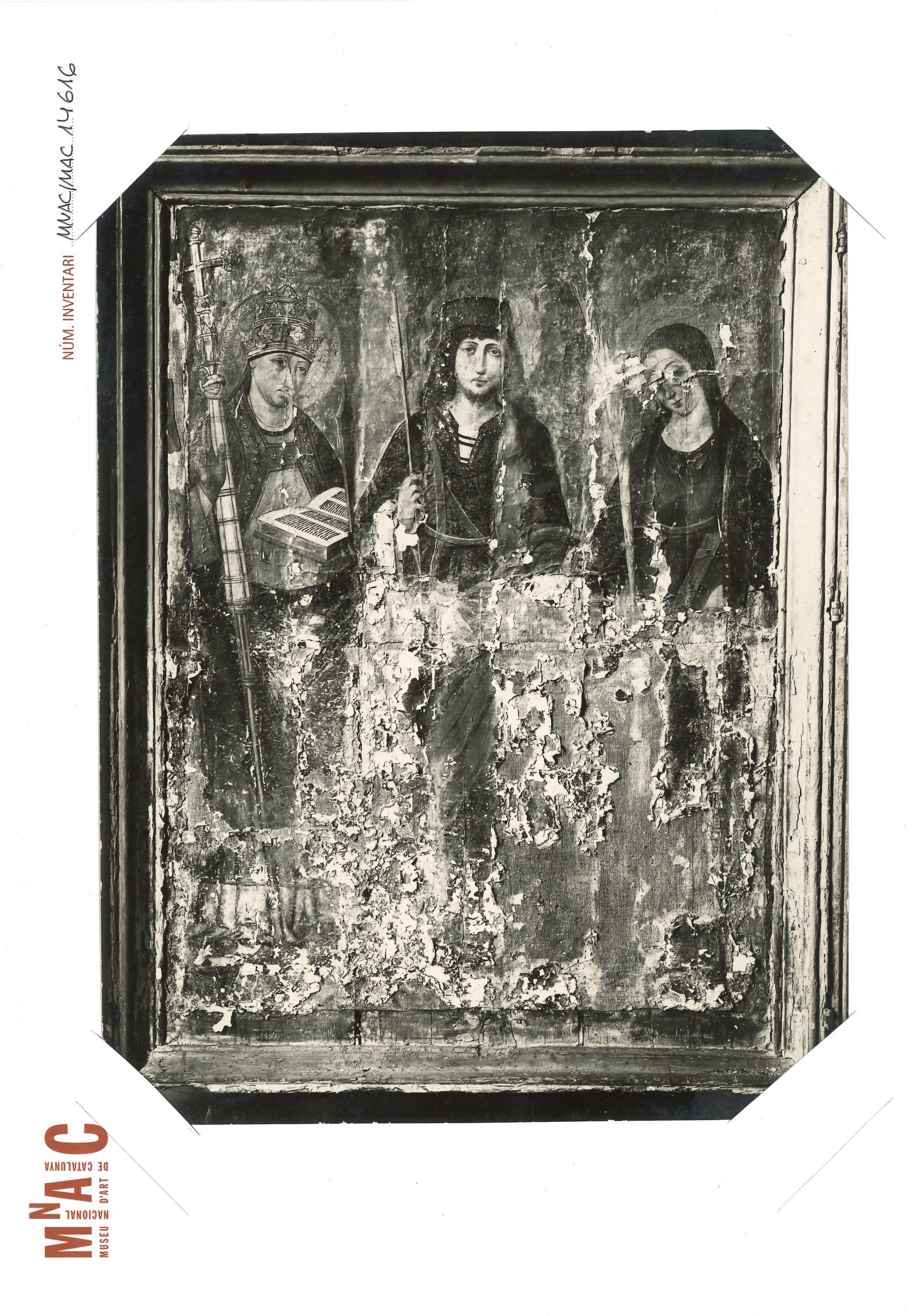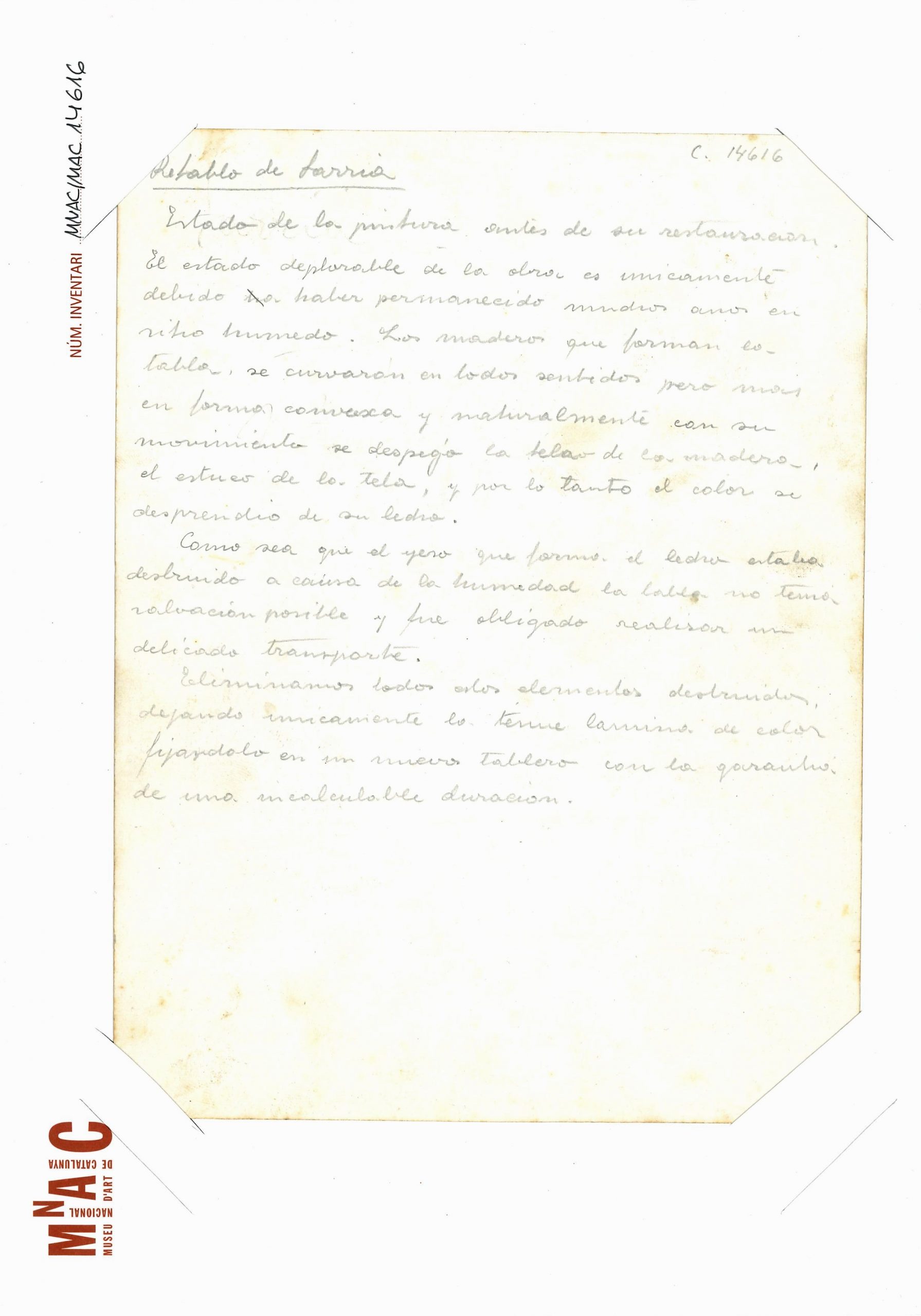Mireia Campuzano i Mireia Mestre
The exhibition Museum in Danger! Safeguarding and Organization of Catalan Art During the Civil War is due to end shortly, having highlighted the steps taken by the museum’s directors and technicians to save the Catalan artistic heritage after the coup d’état. It was a tumultuous period, in which ceaseless efforts were made to achieve different goals – among others, the conservation and restoration of the works of art.
With this blog our intention is to name the conservators-restorers of the time and to provide more information about the work they achieved from 1936 to 1939.
The team of conservators-restorers
According to the archive documents, shortly before the start of the Civil War, the Restoration Service consisted of: Manuel Grau i Mas, head of the Restoration Service since 1931, Domènec Xarrié i Mirambell, hired as a temporary Museums Board employee in 1932, Anton Esteve Querol, who probably joined around 1933, Jesús Arcas Porta, who joined as a carpenter in 1935, and Joaquim Pradell i Ventura, who joined at the end of 1935, aged just 14, as a provisional employee of the Board.
Manuel Grau i Mas / Domènec Xarrié i Mirambell /Anton Esteve Querol (a dalt) / Jesús Arcas Porta / Joaquim Pradell i Ventura.
Of the people mentioned, Manuel Grau had an important role because he represented the first official restorer on the staff of the Barcelona Art Museums. In 1932 he was appointed head of the Restoration Service, under the direction of Joaquim Folch i Torres. It must be remembered that on the initiative of Folch i Torres, the Museums Board offered Manuel Grau the chance to move to Milan to learn how to restore works of art in the workshop of Professor Mauro Pellicioli of the Pinacoteca di Brera.
When he returned from his stay in Milan, the restorer began working in conservation-restoration at the Palau de la Ciutadella, and shortly afterwards the first Restoration Service was created at the new museum in the Palau Nacional, the Museu d’Art de Catalunya.

Manuel Grau and Joaquim Pradell working on the Altarpiece of the Virgin by Jaume Serra (MNAC 15916-CJT). Photographic archive of the Museums of Art.
However, when war broke out, work in the Restoration Service was partially halted. At the end of September 1936, the art collections were moved to the church of Sant Esteve in Olot, to Darnius and Agullana, and to the second floor in Casa Solà Morales (Olot), where the Commissariat-General for Museums and the technical team moved in. Except for Joaquim Pradell, who stayed in the Barcelona Museums office, the restoration staff also moved to Olot to continue their work conserving and restoring the collections.
Moving works from the Museum to the church of Sant Esteve in Olot and to Casa Solà Morales (Olot). Photographic archive of the Museum of Art.
In Olot, the steps taken to save the heritage must have been intense, given that, apart from conserving the collections, Manuel Grau’s team worked on the tasks of preparing the works that were to be part of the exhibition L’Art Catalan du Xè au XVè siècle. They took part in moving the works from Olot to Paris and worked on installing the pieces in the Jeu de Paume and, later, in the Château de Maisons Lafitte.
These circumstances meant that, during the war, the number of staff working on conservation-restoration was quite large. In the minutes of the Commissariat-General for Museums, dated 23 March 1938, it states that the Restoration Service, part of the Museums Section, consisted of eight technicians:

In the minutes of the Commissariat-General for Museums, dated 23 March 1938, it states that the Restoration Service was made up of Manuel Grau, Pau Prou, Josep Mosella, Domènec Xarrié, Jesús Arcas, Josep Altafaja, Antoni Esteve and Rufí Lobo.
This information is interesting, both with regard to the number of restorers, and also to the description of the work they did and how much they were paid. Instead of providing information about a special type of restoration according to the subject and technique of the objects, their duties were defined by a profession typical of the period: draughtsman, mouldmaker, painter, carpenter, silversmith and goldsmith.
What was restored
It is logical to think that the Restoration Service worked on the pieces that were presented in the exhibition L’Art Catalan du Xè au XVè siècle, although no documents describing the work that was achieved have survived. It is very likely that the context of the war and the hasty preparations for the exhibition in Paris generated a form of rapid action, which prevented them from having the chance to make a record of the tasks, let alone photograph them.
Luckily, we have at least two photographs showing the restoration space in the Casa Solà Morales. This space is located in a room with an alcove, which enable us to obtain information about some of the tasks that were carried out. As well, obviously, as the article written by Joaquim Pradell in 2008: Restoration of a panel by Jaume Huguet: the scenes of the Ascension of Christ and the Dormition of the Virgin from the Altarpiece of the Constable, in which he describes the work to strengthen the support of the altarpiece that was undertaken in Olot between 1937 and 1939.
In fact, in one of the abovementioned photographs, Manuel Grau and Jesús Arcas are handling a wooden bar clamp to hold together the uprights and crosspieces of the frame of one of the side panels of the Altarpiece of the Constable. Also, on the left of the picture you can see an open mortise and tenon joint for the construction of the new support, and two dovetails sticking out that needed to be made flush with the surface. It is a magnificent photographic document that corroborates the article by Joaquim Pradell.
On the left, Manel Grau and Josep Altafaja working on the back of the Altarpiece of the Constable, on the back Jesús Arcas. On the right, a detail of two dovetails. Photograph: Joan Vidal i Ventosa.
With respect to the other surviving photograph, the information is equally notable. In the foreground, Domènec Xarrié is working on one of the side panels of the Altarpiece of Saint Fabian, Saint Sebastian and a Holy Martyr (MNAC 14616-CJT), by the Master of the Perea Family, from the late 15th – early 16th century. This altarpiece, which is conserved in the Museu Nacional’s storerooms, is a considerably large artificial articulated triptych coming from the Jesuits of Sarrià. In the photograph, we see the work dismantled with two panels leaning against the wall, the central one and the left-hand side one, the latter dedicated to the Trial of Saint Sebastian; Saint Barbara (MNAC 14616-001), and exhibited in the show Museum in Danger!.
On the left, and from left to right: Manuel Grau, Josep Altafaja and Domènec Xarrié. Photograph: Joan Vidal i Ventosa. On the right, the panel of the Trial of Saint Sebastian; Saint Barbara (MNAC 14616-001) in the show Museum in Danger! Photograph: Marta Mèrida
According to the documents, this triptych was loaned to the museum at the beginning of 1936. Fortunately, several photographs have survived, although they are undated, with inscriptions on the back, in pencil and in Castilian, in which the condition prior to restoration and the work done are mentioned. It is a valuable document for both the content and for the fact that we have an original text written by the museum’s first restorers during the Civil War period.
Front and back of the photograph of the central panel of the Altarpiece of Saint Fabian, Saint Sebastian and a Holy Martyr
Also in the photograph are Manuel Grau, in the centre, working on an unidentified panel with a magnifying glass and a scalpel, and Josep Altafaja, examining a Reliquary attributed to Juan Tol (MNAC 37766), in silver gilt, currently conserved in the Museum’s storerooms.
Josep Altafaja examining a Reliquary from the collection (MNAC 37766).
Despite the paucity of records of the actions carried out by the Restoration Service from 1936 to 1939, it is obvious that their involvement in the safeguarding of the Catalan artistic heritage was of the first order. Like the majority of the professionals who acted to protect the heritage, disciplinary action was also taken against Manuel Grau for his “separatist and propagandistic political ideology of red-separatist ideas”. He was also sanctioned with “disqualification from holding positions of command or of trust”.
In the end, unlike what happened with Joaquim Folch i Torres, the sanction was not implemented and Manuel Grau continued as the head of the Restoration Service until March 1960.






















